Öz
Sodium omadine
(NaOM, sodium pyrithione), a pollutant reaching aquatic ecosystems, used in our
country and the world, is a wide spectrum antimicrobial preservative. In
addition, it is an additive and biocidal (preventing rotting) agent used
against bacterial and fungal growth. The aim of the present study is
determination of the 7 days acute LC50 value of NaOM on the Dreissena
polymorpha, model organism and invasive mussel species of the aquatic ecosystem.
Samples of D.
polymorpha were taken from Hirfanlı Dam Lake and Kesikköprü Dam and transported
to the laboratory under cold conditions, then adapted for one week. Each glass
container had 2 L of water and 15 zebra mussels were stocked in aerated
dechlorinated municipal tap water. Four different exposure dilutions of sodium
omadine (aq. sol., 40%, Arch Chemicals, Inc.) were used for 7 days in the
exposure experiments: 0.1, 0.5, 1, 2, 4 mg/L.
LC50 (mortality) results were estimated using U.S. EPA Probit Analysis Program
v1.5.
Average lenghts
of the mussels were 14.4 mm (± 3.6). The 7 d LC50 value was estimated as 0.243 mg/L (95% confidence interval = 0.735 - 0.016) in the
semistatic bioassay setup. One mussel in the control group (n=15) died on 96 h.
NaOM was found to be very toxic to this indicator species. The only studies
reporting toxicity of NaOM, LC50 values, were trout < 7.3 μg/L and bluegill
sunfish 8100 μg/L. These results show NaOM to be very toxic to aquatic
organisms, and agree with our results.
Anahtar Kelimeler
INVESTIGATION OF ACUTE TOXICITY OF SODIUM OMADINE ON DREISSENA POLYMORPHA (ZEBRA MUSSEL)
Kaynakça
- Feriha YILDIRIM, Kevser YILMAZ, Zeynel UYAR, Figen ERKOÇ
- Department of Environmental Sciences, Institute of Natural and Applied Sciences, Gazi University, Teknikokullar, Ankara, 06500 Department of Biology Education, Gazi Faculty of Education, Gazi University, Teknikokullar, Ankara, 06500
Öz
Kaynakça
- Feriha YILDIRIM, Kevser YILMAZ, Zeynel UYAR, Figen ERKOÇ
- Department of Environmental Sciences, Institute of Natural and Applied Sciences, Gazi University, Teknikokullar, Ankara, 06500 Department of Biology Education, Gazi Faculty of Education, Gazi University, Teknikokullar, Ankara, 06500
Ayrıntılar
| Bölüm | Articles |
|---|---|
| Yazarlar | |
| Yayımlanma Tarihi | 16 Şubat 2017 |
| Yayımlandığı Sayı | Yıl 2017 Cilt: Volume 2 Sayı: İssue 1 (1) - 2.İnternational Congress Of Forensic Toxicology |


